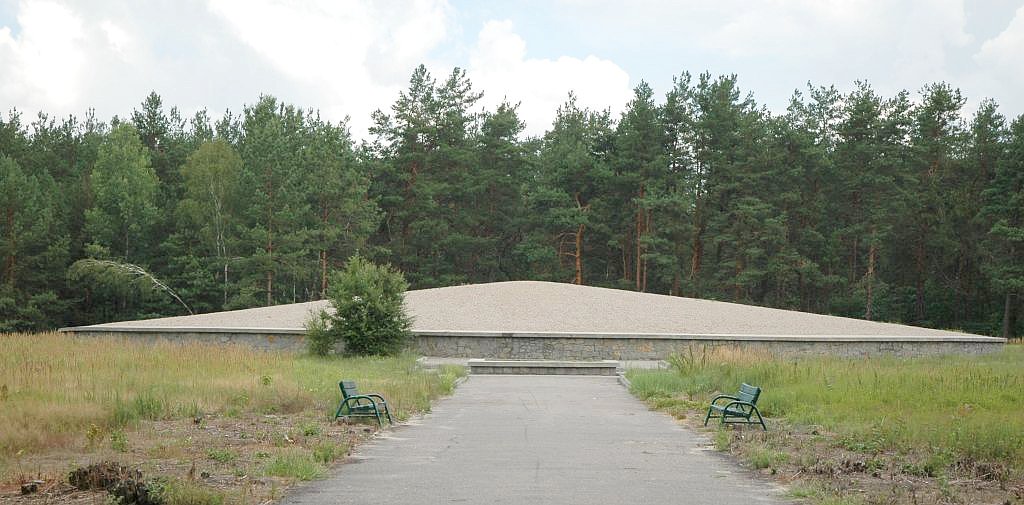This post is also available in: Français Español العربية فارسی Русский Türkçe
Was the extermination area in the Sobibor death camp large enough to contain the mass graves?
Holocaust deniers claim:
The size of Sobibor’s extermination area is too small to have accommodated the number of bodies of the alleged victims.
Specifically, Holocaust deniers claim that it is not possible that the Germans could have “buried roughly the equivalent to the stadium spectators of the Rose Bowl game” (about 80,000 people) in the Sobibor death camp. They say that mass graves were only a little larger than “a henhouse.”[1]
The facts are:
Modern forensic and archeological investigations at Sobibor show that there are at least 7 mass graves in the camp. The size and volume of these graves were more than sufficient to accommodate the number of victims.
Faulty assumptions:
The Holocaust denier known as Denierbud attempts to calculate the size and volume of the mass graves at Sobibor. His numbers are based on the same faulty assumptions he uses for the death camps of Belzec and Treblinka.
First, Denierbud misrepresents the average size of the victims. Second, he assumes how the bodies were thrown into the graves. The way Denierbud describes the Nazis’ burial process would actually waste the space available in the mass graves. Finally, to prove the supposed lack of space at Sobibor, he references a map that is not accurately scaled.
Evidence about the extermination area and the mass graves at Sobibor:
Kurt Bolender, an SS guard at Sobibor, recalled: “The Jewish working brigade put the corpses into rectangularly boarded trolleys and drove them to the mass grave. A mass grave may have been approx. 60 m long, 20 m wide and 6-7 m deep [about 197 feet long by 66 feet wide by 29 to 23 feet deep.] The side walls were sloped like an embankment to avoid the danger of collapse.” In a later interrogation, Bolender spoke of a second pit: “. . . we put corpses in this second pit even before its completion. Above the first pit a layer of sand was spread. After this pit was completely full, the other corpses had to be put somewhere, even though we were not yet finished with the new pit.”[2]
Bolender’s recollection is in accord with preliminary excavations of Sobibor. In 2001, Andrzej Kola conducted a scientific excavation and found seven mass graves, the largest of which was 64 meters by 23 feet by 4.5 meters deep (210 feet by 75 feet by 15 feet deep). The others measured 18 meters by 23 meters by 4.5 meters deep (60 feet by 75 feet by 15 feet deep.)[3]
Ben-Gurion University also conducted thorough archeological studies of Sobibor in 2001, 2007, and 2008. The researchers confirmed the existence of at least seven mass graves. The graves are of varying sizes and they found them to be “heavily mixed with ashes and burnt materials and artifacts.”[4]
In fact, even today the area around the mass graves has distinct traces of darker green grass, indicating a different soil mixture than the surrounding areas. Because of the discolored grass, the locations of the seven mass graves can be seen better from the air. When Isaac Gilead, Yoram Haimi, and Wojciech Mazurek carried out investigations on the Sobibor site, they included aerial photos of the camp in their report. These photos better show the discolored grass that indicates the mass graves.[5]
Conclusion:
Denierbud’s claim, that the only mass grave in the death camp of Sobibor was a little larger than a “hen house,” is false. He employs the same faulty assumptions he used when calculating the mass graves at Belzec and Treblinka. Thus, he arrives at false figures and then applies these faulty calculations to an unscaled map. There were at least seven mass graves at Sobibor; there was plenty of room for both the graves and the incineration grills.

By User:Merlin (Own work) [GFDL (http://www.gnu.org/copyleft/fdl.html), CC-BY-SA-3.0 (http://creativecommons.org/licenses/by-sa/3.0/) or CC BY-SA 2.5-2.0-1.0 (http://creativecommons.org/licenses/by-sa/2.5-2.0-1.0)], via Wikimedia Commons
NOTES
[1] See “One Third of the Holocaust” at http://www.youtube.com/watch?v=taIaG8b2u8I at approximately 1:48 minutes.
[2] ‘Vernehmungsniederschrift of Kurt Bolender of 5 June 1961. ZStL, VII, 252/59, Band II,’ p. 194 and ‘Interrogation of Kurt Bolender of 18 December 1963’. Staatsanwaltschaft Dortmund, Band 35, p. 116 as cited by Carlo Mattogno, Thomas Kues and Jürgen Graf in in The “Extermination Camps” of “Aktion Reinhardt,” Part Two, p. 1286.
[3] “Archeologists find mass graves of Sobibor Nazi death camp,” Ha’aretz (English edition), November 24, 2001 at http://www.fpp.co.uk/Auschwitz/Sobibor/graves_found.html; Mass Graves Confirm Sobibor Holocaust,” The Scotsman, November 26, 2001 at http://www.fpp.co.uk/Auschwitz/Sobibor/Scotsman.html.
[4] Isaac Gilead, Yoram Haimi and Wojciech Mazurek, “Excavating Nazi Extermination Centres” at www.presentpasts.info/article/view/pp.12/2.
[5] Isaac Gilead, Yoram Haimi and Wojciech Mazurek, “Excavating Nazi Extermination Centres” at www.presentpasts.info/article/view/pp.12/2. You may see these areas clearly marked and numbered at Jonathan Harrison, Robert Muehlenkamp, Jason Myers, Sergey Romanov and Nicholas Terry, Belzec, Sobibor, Treblinka: Holocaust Denial and Operation Reinhard. A Critique of the Falsehoods of Mattogno, Graf and Kues, p. 393 at http://holocaustcontroversies.blogspot.com/2011/12/belzec-sobibor-treblinka-holocaust.html. Select Google Docs, Rapidshare or Archive.org for a PDF version.

